Videos by Hilary A Smith
Interview with Dr. Mukta Das about my paper, "Dietary Supplements in Republican China: Boosting V... more Interview with Dr. Mukta Das about my paper, "Dietary Supplements in Republican China: Boosting Vigor by Synthesizing Old and New," discussed at the Modern Chinese Foodways conference hosted by Emory University in April 2021. 8 views
What has Chinese medicine contributed to modern nutritional knowledge? Ever since the 1920s, when... more What has Chinese medicine contributed to modern nutritional knowledge? Ever since the 1920s, when nutrition science began to emerge as a professional discipline in China, open-minded biochemists and nutritionists have suggested that the vitamin-rich remedies in classical texts show that Chinese healers knew how to treat vitamin deficiencies effectively, something that only became possible in nutrition science comparatively recently. But the vitamin, this talk argues, is a peculiar fixation of early twentieth-century scientists. Republican-era (1912-1949) practitioners of Chinese medicine paid little attention to it. Nor is there much evidence that modern nutrition scientists learned a great deal about vitamins or vitamin deficiencies by looking at ancient Chinese texts. This lecture explores how the vitamin came to be so central to Chinese nutrition science, obscuring other meanings of healthy diet expressed in classical texts and in Republican-era Chinese-medicine journals. 79 views
Books by Hilary A Smith

Around the turn of the twentieth century, disorders that Chinese physicians had been writing abou... more Around the turn of the twentieth century, disorders that Chinese physicians had been writing about for over a millennium acquired new identities in Western medicine—sudden turmoil became cholera; flowers of heaven became smallpox; and foot qi became beriberi. Historians have tended to present these new identities as revelations, overlooking evidence that challenges Western ideas about these conditions. In Forgotten Disease, Hilary A. Smith argues that, by privileging nineteenth century sources, we misrepresent what traditional Chinese doctors were seeing and doing, therefore unfairly viewing their medicine as inferior.
Drawing on a wide array of sources, ranging from early Chinese classics to modern scientific research, Smith traces the history of one representative case, foot qi, from the fourth century to the present day. She examines the shifting meanings of disease over time, showing that each transformation reflects the social, political, intellectual, and economic environment. The breathtaking scope of this story offers insights into the world of early Chinese doctors and how their ideas about health, illness, and the body were developing far before the advent of modern medicine. Smith highlights the fact that modern conceptions of these ancient diseases create the impression that the West saved the Chinese from age-old afflictions, when the reality is that many prominent diseases in China were actually brought over as a result of imperialism. She invites the reader to reimagine a history of Chinese medicine that considers its complexity and nuance, rather than uncritically disdaining this dynamic form of healing.
For more information, go to the Stanford University Press website, specifically http://www.sup.org/books/title/?id=25648
Also, check out the interview on the Weatherhead East Asian Institute blog:http://weai.columbia.edu/weai-author-qa-hilary-a-smiths-forgotten-disease/
Articles and Book Chapters (peer-reviewed) by Hilary A Smith
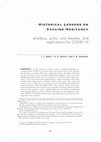
Perspectives in Biology and Medicine, 2023
Vaccine hesitancy continues to pose a formidable obstacle to in- creasing national COVID-19 vacci... more Vaccine hesitancy continues to pose a formidable obstacle to in- creasing national COVID-19 vaccination rates in the US, but this is not the first time that American vaccination efforts have confronted resistance and apathy. This study examines the history of US vaccination efforts against smallpox, polio, and measles, highlighting persistent drivers of vaccine hesitancy as well as factors that helped over- come it. The research reveals that logistical barriers, negative portrayals in the media, and fears about safety stymied inoculation efforts as early as the 18th century and continue to do so. However, vaccine hesitancy has been markedly diminished when trusted community leaders have guided efforts, when ordinary citizens have felt per- sonally invested in the success of the vaccine, and when vaccination efforts have been tied to broader projects to improve public health and social cohesion. Deliberately cultivating such features could be an effective strategy for lessening opposition today, when COVID-19’s distinctive characteristics make addressing vaccine hesitancy more urgent than it has ever been.

History Compass, 2021
CLICK HERE for a freely-available version of the article: https://onlinelibrary.wiley.com/share/a... more CLICK HERE for a freely-available version of the article: https://onlinelibrary.wiley.com/share/author/HZ5T4KDSZFJMHVXKJCUN?target=10.1111/hic3.12704
This essay explores the relationships between food and health in Chinese history, from ancient times to the present. It briefly reviews how historians have written about dietary knowledge in China's past, from a midcentury focus on discoveries that prefigured those of modern nutrition science to a more expansive recent understanding of healthy eating. From there, the piece draws on scholarship from the past 2 decades to highlight the complexity of pre-modern Chinese ideas about food and its connection to ritual, social order, moral rectitude, pleasure, and physical and emotional well-being, all of which factored into dietetic prescriptions and prohibitions. Finally, the last section focuses on the modern period. It suggests that while Western foods and nutrition science acquired great prestige in early twentieth-century China, by the early 21st century both had lost some of their luster, and interest in classical and folk understandings of diet—inflected by the postsocialist political and economic order—was again flourishing.

Moral Foods: The Construction of Nutrition and Health in Modern Asia, edited by Angela Ki Che Leung and Melissa L. Caldwell, 2019
Great news! The University of Hawai'i Press has decided to release this book as a freely availabl... more Great news! The University of Hawai'i Press has decided to release this book as a freely available open-access title. I therefore have attached a pdf of the entire book here, since the other chapters are equally or even more worth reading than the one I wrote. Enjoy!
+++++
"Good Food, Bad Bodies"
This paper explores how and when the modern concept of “lactose intolerance” developed, and what the history of this concept shows us about the context in which modern nutritional science emerged in both China and Western countries.
Lactose intolerance is a peculiar concept. It frames the natural state of most of the global population as an aberration – intolerance – that inhibits them from enjoying an important source of nutrition in the form of dairy. But only about a third of the people in the world today are lactose “tolerant,” meaning that their bodies continue to produce the enzymes necessary to digest lactose, one of the main sugars in milk, after infancy. Recent research suggests that that minority, consisting mostly of Europeans and their descendants, has been lactose “tolerant” for less than seven thousand years, having developed this trait after a genetic mutation spread through what were then small populations in Europe.
In the twentieth century, however, scientists began to treat the genetic mutation of a global minority as the default state of healthy, normal human beings. The idea that lactose intolerance was a medical condition became part of scientific nutritional knowledge. This is not surprising considering that modern nutritional science developed in societies dominated by Europeans who could digest milk. But the influence of Western science in twentieth-century China ensured that lactose intolerance came to be seen as a defect there, too, despite the fact that it was a trait shared by an overwhelming majority of the population.
The transmission and assimilation of this idea in China is particularly intriguing given the long history of ideas about dietary difference expressed in classical Chinese medicine. At least as early as the Yellow Emperor’s Inner Canon, medical writers pronounced that people from different places are suited to different kinds of foods because of differences in their bodies. From at least the thirteenth century, sources presented eating dairy products as a characteristic of northerners, particularly steppe nomads who had hardy constitutions and tended to eat and drink too much.
But in twentieth-century China this old emphasis on regionally appropriate diets gave way to a new universalism, and consuming milk as Westerners did came to be a marker of modernity, not foreignness. The idea that fresh milk was essential to a nutritious, modern diet – especially for young people – became prevalent among elite scientists worldwide. The rub is that while Chinese ideas about diet had changed, the facts of physiology had not. The bodies of Han Chinese adults did not suddenly begin producing lactose-digesting enzymes when nutritional scientists decided that milk was an important part of a healthy modern diet. Consuming fresh milk was as likely to cause cramps, bloating, and diarrhea in China as it had been centuries before. So how did this experience of bodily difference, and the heritage of ideas about regional diets and constitutions, affect the reception of a nutritional concept that privileged the European experience? That is the question this paper addresses.

Moral Foods: The Construction of Nutrition and Health in Modern Asia investigates how foods came ... more Moral Foods: The Construction of Nutrition and Health in Modern Asia investigates how foods came to be established as moral entities, how moral food regimes reveal emerging systems of knowledge and enforcement, and how these developments have contributed to new Asian nutritional knowledge regimes. The collection’s focus on cross-cultural and transhistorical comparisons across Asia brings into view a broad spectrum of modern Asia that extends from East Asia, Southeast Asia, to South Asia, as well as into global communities of Western knowledge, practice, and power outside Asia. The first section, “Good Foods,” focuses on how food norms and rules have been established in modern Asia. Ideas about good foods and good bodies shift at different moments, in some cases privileging local foods and knowledge systems, and in other cases privileging foreign foods and knowledge systems. The second section, “Bad Foods,” focuses on what makes foods bad and even dangerous. Bad foods are not simply ...
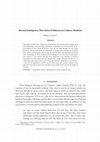
Historia Scientiarum, 2018
This paper explores how Chinese physicians before the modern period thought about the relationshi... more This paper explores how Chinese physicians before the modern period thought about the relationships between eating and illness. It identifies two broad periods in the development of these ideas. In the first, from the late Zhou through the early Tang dynasties, doctors wrote about the importance of balance and moderation to a healthy diet, and the sorts of eating-induced illnesses they discussed were generally associated with overindulgence. These emphases did not disappear in the late imperial period, but they took on a new urgency and they were joined by a new attention to illnesses associated with food deprivation and hunger. This change reflected both the way in which thirteenth-century physician Li Dongyuan raised the eating-illness connection to a new level of significance, and the way in which social and economic change in late
imperial China had focused more attention on the habits of the rich and the plight of the poor.
Global Food History, 2018
Dietary advice that advocates of scientific nutrition offered to Chinese people in the early twen... more Dietary advice that advocates of scientific nutrition offered to Chinese people in the early twentieth century often encouraged them to adopt a Western-style regimen prominently featuring meat, wheat, and dairy. Some East Asian intellectuals, however, promoted science based dietary reforms that did not require a change in the composition of their diets. This article examines one example of such an alternative perspective, a book of dietary advice called On Eliminating Breakfast for Health and to Prevent Aging (Jiankang bulao feizhi zhaoshi lun 健 康不老廢止朝食論), based on a Japanese original and published by the Chinese scholar Jiang Weiqiao 蔣維喬 in 1915.
You can download the full text of the article here:
https://www.tandfonline.com/eprint/prae76iFuErFHt66szNs/full
Asia Major 21, no.1 (2008): 273-292.
pp.170-199 in Xiaochun Sun, ed. Science and the State in the Song Dynasty. Beijing: Science and T... more pp.170-199 in Xiaochun Sun, ed. Science and the State in the Song Dynasty. Beijing: Science and Technology Press, 2007.
pp.207-221 in Henrika Kuklick, ed. A New History of Anthropology. Oxford: Blackwell Publishing, 2... more pp.207-221 in Henrika Kuklick, ed. A New History of Anthropology. Oxford: Blackwell Publishing, 2007.
Outreach Articles and Press (non-peer-reviewed) by Hilary A Smith
Materials for the History of Science: A Whipple Museum Festschrift to Celebrate the Directorship of Professor Liba Taub, 2022
Mini-essay about an object in the collection of the Whipple Museum of the History of Science in C... more Mini-essay about an object in the collection of the Whipple Museum of the History of Science in Cambridge, England, published as part of a 2022 festschrift in honor of Professor Liba Taub, longtime curator of the Whipple Museum and my mentor for a project on this Japanese globe when I was an Phil student at Cambridge. For my mini-essay, see pp.30-31; otherwise, enjoy the other essays and beautiful images about objects collected by the Whipple Museum under Liba's leadership!
Journal of World Philosophies, 2023
These are the proofs of the piece published in the Summer 2023 issue of The Journal of World Phil... more These are the proofs of the piece published in the Summer 2023 issue of The Journal of World Philosophies.
Abstract: This tribute to Nathan Sivin (1931-2022), a pathbreaking scholar of Chinese science, medicine, and philosophy, highlights his distinctive contributions to historical understanding and his memorable wit. I offer a brief biographical sketch followed by an analysis of the main themes in Sivin's voluminous publications and a personal note of appreciation. It is no exaggeration to say that Sivin transformed his field of study. His contrarian spirit, relentless curiosity, and humanistic insight helped make the history of East Asian science, technology, and medicine the vibrant area of study that it is today.
News of the Profession: Eloge Nathan Sivin (1931-2022), 2023
This Eloge in memory of Nathan Sivin was co-authored with Michael Nylan and Hilary Smith

For Chinese readers: summary of a talk I gave at the Institute of History and Philology, Academia... more For Chinese readers: summary of a talk I gave at the Institute of History and Philology, Academia Sinica, Taiwan, November 20, 2019. Click on the link below (or go to the following URL: http://mingching.sinica.edu.tw/Academic_Detail/844) to read the summary on the website of the Committee for the Promotion of Ming-Qing Studies. I have also pasted it below.
講題: 科學與養生:晚清與民國時期的飲食指南
主講人: 司馬蕾 (Hilary A. Smith) 教授(美國丹佛大學歷史學系)
主持人: 李尚仁教授(中央研究院歷史語言研究所)
時間: 2019 年 11 月 20 日(三)下午 3:00 至 5:00
地點: 中央研究院歷史語言研究所 研究大樓 701 會議室
撰寫人: 鄧涵云(國立臺灣大學中國文學研究所碩士生)
本次中研院史語所生命醫療史研究室邀請到美國丹佛大學歷史系副教授司馬蕾 (Hilary A. Smith),以「科學與養生:晚清與民國時期的飲食指南」為題進行演講。司馬蕾教授甫出版新書 Forgotten Disease: Illnesses Transformed in Chinese Medicine,探討腳氣病在中國的歷史,闡述腳氣病在中國不同階段、不同醫學知識背景之下如何被理解。
司馬蕾教授之所以開始研究腳氣病,是源自對營養相關問題,尤其是健康飲食 (healthy eating) 觀念演變的關心。二十世紀以來,人們對「腳氣病」的理解是缺乏維他命的疾病,但是深入研究之後,發現中國「腳氣病」的歷史比想像中複雜得多,大部分傳統中醫關於「腳氣」的論述和營養缺乏之間沒有關聯,於是便逐漸走入了與營養問題截然不同的方向,並開始對清末民初這段時期產生興趣,因為此時期正是決定現代對腳氣病理解的關鍵,從傳統的「腳氣」(foot qi) 轉變為現代所理解的「營養缺乏病」(beriberi)。十九世紀末至二十世紀初的人們試著將發生在中國的所有新事物拼湊成有系統的樣貌,當時人們的想法多元並陳、創意十足,顯得特別有趣且迷人。成書之後,司馬蕾教授仍對營養問題抱持興趣,於是新的計劃聚焦於清末民初的營養問題研究,本次演講便是與大家分享目前正在進行的新研究計畫。
司馬蕾教授正在進行的計畫寫作是 Making Modern Diets: Science and Sustenance in China,考察清末民初中國關於健康飲食的論述,以釐清「養生」和營養學 (nutrition science) 之間的關係為何,兩者如何互相影響?人們認為中國的飲食是否應該要與西方飲食相似?原因為何?此研究主要奠基在幾篇先行研究之上:李尚仁的 “Eating Well in China”、傅家倩 (Jia-Chen Fu) 的 The Other Milk、Seung-Joon Lee 之 “The Patriot’s Scientific Diet”、Mark Swislocki 之 “Nutritional Governmentality”、梁其姿 的 “To Build or to Transform Vegetarian China?”。這些研究成果指出,健康或不健康飲食的觀念受到政治和文化的影響,和受到實證研究的影響一樣深。李尚仁提出英國對中國飲食的評判,反映了大英帝國和中國的政治關係,並且被和印度飲食相互比較。傅家倩於 The Other Milk 第三章指出,營養學家(如:吳憲)將中國飲食視為營養缺乏的,雖然在科學數據上,結果差異相當大,正反論述都有很多數據支持。梁其姿則是點出中國直到 1920 年代都將茹素視為健康的飲食習慣 (scientifically healthy),但是 1920 年後開始視其為不健康的作法 (scientifically unhealthy),然而在此期間實驗數據並未有顯著的差異。
因此,司馬蕾教授假設,近代營養學其實並沒有真正指導人們關於健康飲食的問題,他們常常提出完全相反的理論,例如某次提出每日喝酒有益健康,不久之後又會有研究指出每日喝酒容易致癌。對於這樣的情形,給出較好解釋的是 Gyorgy Scrinis 的 Nutritionism,他追溯了十九世紀中葉以來營養學的歷史,提出科學研究的本質是歸納出一個結論,但飲食在日常中有太多變因,不同食材結合時也會產生化學變化,沒有辦法被歸納之後給定結論。再者,營養學實驗極度難以設計,研究只能依靠受試著回憶其所吃下的食物進行研究。因此就算得到了實驗數據,也難以化為能使人日常奉行的指引。不過在二、三零年代,科學家尚未發現此事的困難性,他們認為能夠掌握、操控飲食與營養問題,並希望透過實證提出終極的飲食。所以十九世紀他們積極地進行研究、實驗,例如把人放在一個箱子裡面,科學家能掌握所有此人攝取的、排出的物質,這樣就能掌握人們在不同行為下所需的熱量。
前述的受試者通常是歐洲的成人,並且是在歐美的情境下,因此並非完全適用於中國,但是中國並未反對這些營養攝取準則,而是不停地適應。清末民初的營養學知識可被分為三個時期檢視,首先是十九世紀末至 1920 年代初,開始出現了科學知識與傳統知識、民間知識的結合,接著是二零年代到 1937 年,這段期間中國開始了專業營養學,並將西方營養學當作標準,亦是在此時期,「中國的飲食」(the Chinese Diet) 問題產生,人們開始定義這個問題。最後是 1937 年至 1949 年,由於正處戰爭時代,專業營養學家忙於和緊急狀況搏鬥,例如難民、軍隊的糧食供應。
本次演講著重分析第一個時期:十九世紀末至 1920 年代初,此時可以蔣維喬 (1873-1958)、丁福保 (1874-1952) 為代表。兩人有許多相似處,包含兩人皆翻譯過許多日文著作,曾接觸多種不同的工作,代表他們在晚清動盪之中的諸多嘗試。他們亦都對佛教、養身的觀念有深厚知識,又對西方營養學抱持興趣,他們對健康飲食的看法可以被稱作「中立的多元主義」(Even-handed Pluralism)。
蔣維喬在 1915 年出版《健康不老廢止朝食論》,該作根據美島近一郎的作品輯述而成,並且加入自己的看法。該書倡導不吃早餐的好處,並且提出「每日只吃兩次,十二時以前一次,下午一次」的飲食準則。值得注意的是,這本書的論述完全奠基於科學的身體 (scientific body),是在符合當代理解的架構下,因此使用「營養」的觀念,並區分「心」和「身」,又強調「血」而不談「氣」,重視大腸,忽略脾,認為腦、神經系統很重要,且重視人體胃腸當中微生物的存在。蔣維喬在輯述美島近一郎的作品時,並未摻入中醫的觀念,但是有趣的是,他給出的結論和建議和同時期的西方理論相當不同。
Rachel Laudan 於 Cuisine and Empire (2013) 指出,二十世紀初西方的飲食決定論 (Dietary Determinism) 認為,人們的飲食決定了國力的強弱,如果飲食和最強大的國家相同,也會變得更加富有、強壯,因此弱小的國家應該要鼓勵人民飲食向西方學習,例如多吃奶類、小麥、牛肉等。這個觀點後來由吳憲、侯祥川、鄭集等營養學家在 1920 年代傳至中國並提倡。在 1930 年代,吳憲比較了「吃米飯的亞洲人」與「吃肉、奶、蛋的歐洲和美國人」的體格和力氣,得出米飯較為弱勢的結論。然而,蔣維喬提出了截然不同的「飲食決定論」,在其《健康不老廢止朝食論》一書中,他也認為飲食決定了人、國家的樣態,不過決定國力強弱的並非「吃什麼」,而是「怎麼吃」。蔣維喬在該作的序言指出,廢止朝食的目的是維持體內每個臟器的平衡、維持人和國家和諧。美島近一郎原本的寫作目的是養生、長生,但是蔣維喬把重點換成了臟器,乃至人、國家之間的和諧、不相殺。這樣的想法應是受到黃帝內經、佛教或道教的影響,因而導出了和西方不同的飲食決定論。
至於丁福保的衛生和生理學的論著,其中《衛生學問答》是他較早期的一部作品,丁福保所使用的「衛生」一詞,不同於我們目前對「衛生」的定義,而較相近於西方早期的 “hygiene” 定義,不僅是潔淨,還包含健康層面:運動、性、飲食,甚至是心理健康。在這部著作當中,丁福保接受了西方對「消化」的理解。例如當中有一段問答:「問中醫書云,脾胃並能消食。今云脾生白血輪者何故。」、「答脾與胃不相連,於消食之事,絕不相干。惟主生白血輪。此乃西人近來考得之新理。」看似提供了一個對於人體的全新詮釋,但是在結論處,他又以「素問云,脾統血。此說近似矣」,這個中醫傳統的說法作結。這是他撰寫此書的固定模式,提出西方說法後再引一段中醫經典印證、作結。司馬蕾教授認為,丁福保身為醫生,作品一方面認同當時的西方營養與心理學,另一方面反映中國傳統的飲食觀念,此事主要可以由丁福保如何看待牛奶或者乳製品,以及「熱」(heat) 的問題上觀察。
二十世紀初以來,西方人認為牛奶是自然界最完美的食品 (nature's perfect food),丁福保和西方相同,都強調蛋、奶以及乳製品的好處,曾提倡「蛋為第一種食品」、「人身所需之料,幾乎全在蛋內」、「牛乳亦為佳品,其功效與蛋相」,更在其《家庭侍疾法》(1910) 中,將牛乳、牛乳越幾斯 (milk extract)、牛酪、乾酪、乳清列為適合侍疾的食物。不過丁福保指出,其中乳清「有催進消化之效」這一說法未見於西方論述之中,司馬蕾教授提出,此說法或許和我們現今所認知的乳糖不耐症有關。另外,丁福保是將乳製品視為「侍疾用」之食物,且在其前言論述道,不可予病患食用「一般」食物,由此可見丁福保不將乳製品視為一般食品,這樣的觀念較接近於中醫以奶入藥的做法,與西方觀點不同。在中醫傳統上,牛奶至少早至八世紀就已經被當作藥材,尤其是用於對治因過多「熱」(heat) 所導致的病症,如消渴症(今「糖尿病」)。
「熱」(heat) 在二十世紀初期的西方營養學中占有重要的地位,其討論內容包含食物的熱量 (food calorie) 和熱殺菌 (heat sterilization),而在丁福保的論述中,與此相關的論述如下:
食品分之為二,曰動物性食品,曰植物性食品。皆含有水與糖,及脂肪,鹽類,蛋白質者也。蔬菜之類 … 含油甚少,宜於夏。魚肉之類 … 含油甚多,宜於冬,蓋油質能多生身熱也。《蒙學衛生教科書》
水內之微生物最多。腹中受之,易以致病。故飲水宜煎之至沸。《蒙學衛生教科書》
北方常寒,宜多食動物。南方常熱,宜多食植物。使極北之人遷於煖地,令常食饅頭菜類等食料,雖欲多飲油質而不納矣。使有南方而遷至極北最冷處者,其嗜好竟能全變,亦以油質為最美之味。《衛生學問答》
大汗口渴之時,宜禁飲冷水,否則肺必受病。《蒙學衛生教科書》
由上引論述可知,雖然不使用「熱量」(calorie) 一詞,但是丁福保運用的正是熱量的觀念描述各類食物;並且,丁福保也有應使用高熱殺菌的觀念。另外,丁福保認為應該要根據不同的地區環境狀況調整飲食,還有在身體處於熱的狀態時不能喝冷水,這些說法未曾出現在西方論述之中,西方觀點認為應該根據性別、年齡調整合適的飲食,卻未談及根據地域調整。故而,司馬蕾教授總結,丁福保看待健康飲食的方式既符合現代眼光,又有其特別之處;丁福保受到營養學知識的啟發,同時吸納來自不同知識脈絡的觀點。
最後,司馬蕾教授展示了 2013 年上海交通大學出版社《人體使用手冊:親子漫畫版》當中,教導孩子們身體熱時喝冷水的危險性的漫畫,說明民國初期關於健康飲食的觀念至今仍然為當代人所沿襲。
演講結束後,在場學者首先討論美島近一郎的著作思想來源之使用問題,推測有可能是來自當時日本對荷蘭健康養生觀念的閱讀與接受。不過司馬蕾教授特別回應,關於一天究竟該吃幾餐的問題,應該並非來自西方,有可能是美島近一郎自己的發明。之後,雷祥麟教授詢問,為什麼對於減少進食次數的觀念,美島近一郎和蔣維喬倡導的是略過早餐,而非午餐或晚餐?臺灣的食療養生專家莊淑旂所倡導的便是略過晚餐。另外,「促進消化」的想法從何而來?當我們談「促進」消化,即意指消化不會完全自動完成,而需要外力推動,營養的食物可能難以消化。司馬蕾教授回應,美島近一郎和蔣維喬提倡略過早餐時的論述是,早上剛起床是充滿了純粹能量的時候,若是進食將破壞這樣純粹的能量,非常可惜。這也和西方相當強調完全消化所需的時間和精力有關。促進消化的部分,「消化不良」常見於診斷之中,丁福保在書中也有論及,這樣的感受也為我們日常體驗,至於背後的理論和意義則尚需進一步研究。
另有學者提出,曾經在十九世紀傳教士日記中讀到,中國的下層階級時常有消化不良的問題,他們由於貧窮而沒有機會吃到肉,於是總是盡可能地用大量的饅頭填飽肚子,因為吃下了過多此類食物,所以常常消化不良。司馬蕾教授對此談到,這使人想起電影《活著》當中,餓過頭的醫生狂吃饅頭的場景。祝平一教授和李貞德教授則提問,我們該多大程度地相信或遵循這些飲食建議?因為提出建議者本身可能受到出版社、贊助者或個人想要出名等因素影響,而給出特立獨行的建議;又因為從蔣維喬到莊淑旂直到現代,遇到飲食、營養相關的主題,都會受到來自各個不同國家文化、各種脈絡的論述影響,思考總是混雜 (hybrid),那麼我們該如何看待這些飲食建議?司馬蕾教授回應,蔣維喬和丁福保透過他們的著作所想要做的相當不同,且各個營養相關的論述的確都是混雜的,所以我們該如何面對他們的作品,是一個相當值得深入探討的問題。
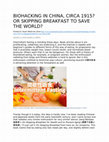
Asian Medicine Zone, 2019
The website Asian Medicine Zone, where this piece originally appeared, is being decommissioned. S... more The website Asian Medicine Zone, where this piece originally appeared, is being decommissioned. So I paste the original post here:
Biohacking in China, circa 1915? Or Skipping Breakfast to Save the World?
August 3, 2019 Hilary A. Smith
Intermittent fasting is trending these days. News articles about it are proliferating, celebrities are endorsing it, and the Internet is replete with beginner’s guides to different forms of this way of eating. Its proponents say that it promotes weight loss, lowers insulin levels, and normalizes blood pressure. Others warn that it can be dangerous—for those with a history of disordered eating, for example, or pregnant women. But the enthusiasm radiating from blogs and fitness websites is hard to ignore. Nor is this enthusiasm confined to American pop culture: jianxiexing duanshi 间歇性断食 is attracting attention in the Sinosphere as well.
Trendy though it is today, the idea is hardly new . I’ve been reading Chinese and Japanese books from the early twentieth century, and I came across one that radiates very similar enthusiasm for very similar advice: Jiang Weiqiao 蔣維喬’s On Skipping Breakfast for Health and to Prevent Aging (健康不老廢止朝食論). I’ll just call it On Skipping Breakfast from here on, for simplicity. This book claims that by eating only two meals per day, one slightly before noon and one in the early evening, anyone can improve his health and extend his lifespan. Following this advice, it says, can strengthen cases of weak nerves and prevent conditions such as depression, diabetes and obesity, constipation, and even cholera and typhoid. And, as if that weren’t enough, it gives the eater more time, improves his mental clarity, and makes him more successful in his career. When Twitter CEO Jack Dorsey says that intermittent fasting “helps him save time, stay focused, and sleep better at night,” it’s almost as if he’s quoting Jiang.[1] Or actually, quoting Mishima Kin’ichirō 美島金一郎,since Jiang’s book is a modified translation of a Japanese book published a year earlier.
But On Skipping Breakfast is not just an example of biohacking before Silicon Valley. While Mishima’s original text does celebrate the potential to lighten the body and boost productivity, Jiang’s version has higher aims: his ambition is to “arrive at a world of great harmony” by promoting moderate eating.
When the Commercial Press published the book in 1915, Western scientific ideas about eating were beginning to permeate China. Increasingly, diets were defined, measured, and quantified as the concepts of calories, vitamins, and minimum daily requirements took root. Underpinning much of this knowledge was a conviction that Western diets were superior to what people ate in East Asia. Scientists as well as political and cultural leaders decried Chinese diets as deficient—in proteins, in calories, in micronutrients and in just about every other way. Modernizers in China, like those in other weak countries, wanted their people to adopt what Rachel Laudan has called the “power cuisine” of the West, a high-calorie feast featuring meat, wheat, and dairy.[2] The goal was to create a taller, stronger, and generally more “fit” population that could better compete in the nations’ struggle for survival.
On Skipping Breakfast, though, approaches the question of national diet very differently. It’s not that Jiang rejects modern knowledge. By choosing to translate Mishima’s tract in all its scientistic glory, Jiang demonstrates his fascination with then-current physiological and anatomical ideas. The body described in this book is clearly the body of Western science, not the one of classical Chinese medicine: it has blood but no qi, yingyang (營養, the neologism “nutrition”) but no yin 陰 or yang 陽, and a mind-hosting brain instead of a heart-mind (xin 心), among many other marks. The book revels in mechanistic descriptions of digestion and excretion. But Jiang harnesses these ideas to a very different goal from the usual one of bulking up to better compete.[3]
In a preface added to Mishima’s original text, Jiang affirms the Darwinian premise that all living beings are locked in a struggle for survival. But his response sounds like a Buddhist one:
“if there were a way to make living things able to not rely on food to live, then their conflict and killing one another perhaps could be stopped. If there were a way to … make living things return and not be reborn and not die … [t]he conflict and mutual killing could forever not be aroused.”
Unfortunately, he writes,
“there is not yet a good method of not eating. So we will use eating in moderation to save [people]. When there have been generations who have practiced healthy, anti-aging [practices like these] for a long time, this can build up their self-cultivation and produce wisdom, and engrave the truth of no-rebirth.”[4]
Here the goal is not to win the competition but to transcend it. Rather than improving their stock by eating more animal protein and calories, nations can improve their moral essence by eating in a disciplined and economical pattern. Jiang’s perspective echoes not only Buddhist ideals but also Daoist practices like abstaining from grain. It resonates, too, with what Chinese medical classics say about moderating what you eat and drink.
Despite (or perhaps because of) its ties to traditional culture, On Skipping Breakfast clearly remained a contrarian piece. China did indeed absorb Western “power cuisine.” A century later, the attendant problems of a calorie-dense diet heavier in meat, wheat, and dairy have cropped up there, including rising rates of obesity, diabetes, and high blood pressure. No wonder, then, that these days intermittent fasting is attracting attention in Chinese societies too. Today, though, you’re less likely to hear about its potential to save humanity.
[1] Aria Bendix and Julia Naftulin, “Twitter CEO Jack Dorsey says he eats only one meal a day and fasts all weekend,” Business Insider April 12, 2019 (https://www.businessinsider.com/jack-dorsey-intermittent-fasting-diet-risks-2019-4)
[2] Rachel Laudan, Cuisine and Empire: Cooking in World History (Berkeley: University of California Press, 2013), 255-257.
[3] Hilary A. Smith, “Skipping Breakfast to Save the Nation: A Different Kind of Dietary Determinism in Early Twentieth-Century China,” Global Food History vol.4, no.2 (2018): 152-167.
[4] Jiang Weiqiao, Jiankang bulao feizhi zhaoshi lun [Skipping Breakfast for Health and to Prevent Aging] (Taipei: Xin wen feng, 1980), author’s preface 2 and 5.
We are excited to announce a new title in the Studies of the Weatherhead East Asian Institute boo... more We are excited to announce a new title in the Studies of the Weatherhead East Asian Institute book series: Forgotten Disease: Illnesses Transformed in Chinese Medicine, published by Stanford University Press. The book's author is Hilary A. Smith, an assistant professor of history at the University of Denver.
Videos (lectures and interviews) by Hilary A Smith
This talk was presented on January 27, 2021 as part of the Grand Rounds series in the Department ... more This talk was presented on January 27, 2021 as part of the Grand Rounds series in the Department of Medicine at the UCSD School of Medicine. It examines four twentieth-century examples of attempts to manage or eradicate infectious disease (smallpox, polio, malaria, tuberculosis) and asks what insights this history offers as we look forward to the end of the COVID-19 pandemic.
The talk is no longer available to stream from UCSD's website, but if you would like access to it, you can reach out to medchair@health.ucsd.edu.



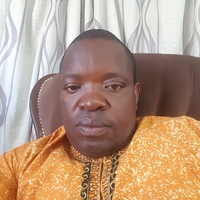

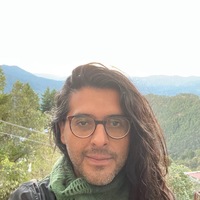




Uploads
Videos by Hilary A Smith
Books by Hilary A Smith
Drawing on a wide array of sources, ranging from early Chinese classics to modern scientific research, Smith traces the history of one representative case, foot qi, from the fourth century to the present day. She examines the shifting meanings of disease over time, showing that each transformation reflects the social, political, intellectual, and economic environment. The breathtaking scope of this story offers insights into the world of early Chinese doctors and how their ideas about health, illness, and the body were developing far before the advent of modern medicine. Smith highlights the fact that modern conceptions of these ancient diseases create the impression that the West saved the Chinese from age-old afflictions, when the reality is that many prominent diseases in China were actually brought over as a result of imperialism. She invites the reader to reimagine a history of Chinese medicine that considers its complexity and nuance, rather than uncritically disdaining this dynamic form of healing.
For more information, go to the Stanford University Press website, specifically http://www.sup.org/books/title/?id=25648
Also, check out the interview on the Weatherhead East Asian Institute blog:http://weai.columbia.edu/weai-author-qa-hilary-a-smiths-forgotten-disease/
Articles and Book Chapters (peer-reviewed) by Hilary A Smith
This essay explores the relationships between food and health in Chinese history, from ancient times to the present. It briefly reviews how historians have written about dietary knowledge in China's past, from a midcentury focus on discoveries that prefigured those of modern nutrition science to a more expansive recent understanding of healthy eating. From there, the piece draws on scholarship from the past 2 decades to highlight the complexity of pre-modern Chinese ideas about food and its connection to ritual, social order, moral rectitude, pleasure, and physical and emotional well-being, all of which factored into dietetic prescriptions and prohibitions. Finally, the last section focuses on the modern period. It suggests that while Western foods and nutrition science acquired great prestige in early twentieth-century China, by the early 21st century both had lost some of their luster, and interest in classical and folk understandings of diet—inflected by the postsocialist political and economic order—was again flourishing.
+++++
"Good Food, Bad Bodies"
This paper explores how and when the modern concept of “lactose intolerance” developed, and what the history of this concept shows us about the context in which modern nutritional science emerged in both China and Western countries.
Lactose intolerance is a peculiar concept. It frames the natural state of most of the global population as an aberration – intolerance – that inhibits them from enjoying an important source of nutrition in the form of dairy. But only about a third of the people in the world today are lactose “tolerant,” meaning that their bodies continue to produce the enzymes necessary to digest lactose, one of the main sugars in milk, after infancy. Recent research suggests that that minority, consisting mostly of Europeans and their descendants, has been lactose “tolerant” for less than seven thousand years, having developed this trait after a genetic mutation spread through what were then small populations in Europe.
In the twentieth century, however, scientists began to treat the genetic mutation of a global minority as the default state of healthy, normal human beings. The idea that lactose intolerance was a medical condition became part of scientific nutritional knowledge. This is not surprising considering that modern nutritional science developed in societies dominated by Europeans who could digest milk. But the influence of Western science in twentieth-century China ensured that lactose intolerance came to be seen as a defect there, too, despite the fact that it was a trait shared by an overwhelming majority of the population.
The transmission and assimilation of this idea in China is particularly intriguing given the long history of ideas about dietary difference expressed in classical Chinese medicine. At least as early as the Yellow Emperor’s Inner Canon, medical writers pronounced that people from different places are suited to different kinds of foods because of differences in their bodies. From at least the thirteenth century, sources presented eating dairy products as a characteristic of northerners, particularly steppe nomads who had hardy constitutions and tended to eat and drink too much.
But in twentieth-century China this old emphasis on regionally appropriate diets gave way to a new universalism, and consuming milk as Westerners did came to be a marker of modernity, not foreignness. The idea that fresh milk was essential to a nutritious, modern diet – especially for young people – became prevalent among elite scientists worldwide. The rub is that while Chinese ideas about diet had changed, the facts of physiology had not. The bodies of Han Chinese adults did not suddenly begin producing lactose-digesting enzymes when nutritional scientists decided that milk was an important part of a healthy modern diet. Consuming fresh milk was as likely to cause cramps, bloating, and diarrhea in China as it had been centuries before. So how did this experience of bodily difference, and the heritage of ideas about regional diets and constitutions, affect the reception of a nutritional concept that privileged the European experience? That is the question this paper addresses.
imperial China had focused more attention on the habits of the rich and the plight of the poor.
You can download the full text of the article here:
https://www.tandfonline.com/eprint/prae76iFuErFHt66szNs/full
Outreach Articles and Press (non-peer-reviewed) by Hilary A Smith
Abstract: This tribute to Nathan Sivin (1931-2022), a pathbreaking scholar of Chinese science, medicine, and philosophy, highlights his distinctive contributions to historical understanding and his memorable wit. I offer a brief biographical sketch followed by an analysis of the main themes in Sivin's voluminous publications and a personal note of appreciation. It is no exaggeration to say that Sivin transformed his field of study. His contrarian spirit, relentless curiosity, and humanistic insight helped make the history of East Asian science, technology, and medicine the vibrant area of study that it is today.
講題: 科學與養生:晚清與民國時期的飲食指南
主講人: 司馬蕾 (Hilary A. Smith) 教授(美國丹佛大學歷史學系)
主持人: 李尚仁教授(中央研究院歷史語言研究所)
時間: 2019 年 11 月 20 日(三)下午 3:00 至 5:00
地點: 中央研究院歷史語言研究所 研究大樓 701 會議室
撰寫人: 鄧涵云(國立臺灣大學中國文學研究所碩士生)
本次中研院史語所生命醫療史研究室邀請到美國丹佛大學歷史系副教授司馬蕾 (Hilary A. Smith),以「科學與養生:晚清與民國時期的飲食指南」為題進行演講。司馬蕾教授甫出版新書 Forgotten Disease: Illnesses Transformed in Chinese Medicine,探討腳氣病在中國的歷史,闡述腳氣病在中國不同階段、不同醫學知識背景之下如何被理解。
司馬蕾教授之所以開始研究腳氣病,是源自對營養相關問題,尤其是健康飲食 (healthy eating) 觀念演變的關心。二十世紀以來,人們對「腳氣病」的理解是缺乏維他命的疾病,但是深入研究之後,發現中國「腳氣病」的歷史比想像中複雜得多,大部分傳統中醫關於「腳氣」的論述和營養缺乏之間沒有關聯,於是便逐漸走入了與營養問題截然不同的方向,並開始對清末民初這段時期產生興趣,因為此時期正是決定現代對腳氣病理解的關鍵,從傳統的「腳氣」(foot qi) 轉變為現代所理解的「營養缺乏病」(beriberi)。十九世紀末至二十世紀初的人們試著將發生在中國的所有新事物拼湊成有系統的樣貌,當時人們的想法多元並陳、創意十足,顯得特別有趣且迷人。成書之後,司馬蕾教授仍對營養問題抱持興趣,於是新的計劃聚焦於清末民初的營養問題研究,本次演講便是與大家分享目前正在進行的新研究計畫。
司馬蕾教授正在進行的計畫寫作是 Making Modern Diets: Science and Sustenance in China,考察清末民初中國關於健康飲食的論述,以釐清「養生」和營養學 (nutrition science) 之間的關係為何,兩者如何互相影響?人們認為中國的飲食是否應該要與西方飲食相似?原因為何?此研究主要奠基在幾篇先行研究之上:李尚仁的 “Eating Well in China”、傅家倩 (Jia-Chen Fu) 的 The Other Milk、Seung-Joon Lee 之 “The Patriot’s Scientific Diet”、Mark Swislocki 之 “Nutritional Governmentality”、梁其姿 的 “To Build or to Transform Vegetarian China?”。這些研究成果指出,健康或不健康飲食的觀念受到政治和文化的影響,和受到實證研究的影響一樣深。李尚仁提出英國對中國飲食的評判,反映了大英帝國和中國的政治關係,並且被和印度飲食相互比較。傅家倩於 The Other Milk 第三章指出,營養學家(如:吳憲)將中國飲食視為營養缺乏的,雖然在科學數據上,結果差異相當大,正反論述都有很多數據支持。梁其姿則是點出中國直到 1920 年代都將茹素視為健康的飲食習慣 (scientifically healthy),但是 1920 年後開始視其為不健康的作法 (scientifically unhealthy),然而在此期間實驗數據並未有顯著的差異。
因此,司馬蕾教授假設,近代營養學其實並沒有真正指導人們關於健康飲食的問題,他們常常提出完全相反的理論,例如某次提出每日喝酒有益健康,不久之後又會有研究指出每日喝酒容易致癌。對於這樣的情形,給出較好解釋的是 Gyorgy Scrinis 的 Nutritionism,他追溯了十九世紀中葉以來營養學的歷史,提出科學研究的本質是歸納出一個結論,但飲食在日常中有太多變因,不同食材結合時也會產生化學變化,沒有辦法被歸納之後給定結論。再者,營養學實驗極度難以設計,研究只能依靠受試著回憶其所吃下的食物進行研究。因此就算得到了實驗數據,也難以化為能使人日常奉行的指引。不過在二、三零年代,科學家尚未發現此事的困難性,他們認為能夠掌握、操控飲食與營養問題,並希望透過實證提出終極的飲食。所以十九世紀他們積極地進行研究、實驗,例如把人放在一個箱子裡面,科學家能掌握所有此人攝取的、排出的物質,這樣就能掌握人們在不同行為下所需的熱量。
前述的受試者通常是歐洲的成人,並且是在歐美的情境下,因此並非完全適用於中國,但是中國並未反對這些營養攝取準則,而是不停地適應。清末民初的營養學知識可被分為三個時期檢視,首先是十九世紀末至 1920 年代初,開始出現了科學知識與傳統知識、民間知識的結合,接著是二零年代到 1937 年,這段期間中國開始了專業營養學,並將西方營養學當作標準,亦是在此時期,「中國的飲食」(the Chinese Diet) 問題產生,人們開始定義這個問題。最後是 1937 年至 1949 年,由於正處戰爭時代,專業營養學家忙於和緊急狀況搏鬥,例如難民、軍隊的糧食供應。
本次演講著重分析第一個時期:十九世紀末至 1920 年代初,此時可以蔣維喬 (1873-1958)、丁福保 (1874-1952) 為代表。兩人有許多相似處,包含兩人皆翻譯過許多日文著作,曾接觸多種不同的工作,代表他們在晚清動盪之中的諸多嘗試。他們亦都對佛教、養身的觀念有深厚知識,又對西方營養學抱持興趣,他們對健康飲食的看法可以被稱作「中立的多元主義」(Even-handed Pluralism)。
蔣維喬在 1915 年出版《健康不老廢止朝食論》,該作根據美島近一郎的作品輯述而成,並且加入自己的看法。該書倡導不吃早餐的好處,並且提出「每日只吃兩次,十二時以前一次,下午一次」的飲食準則。值得注意的是,這本書的論述完全奠基於科學的身體 (scientific body),是在符合當代理解的架構下,因此使用「營養」的觀念,並區分「心」和「身」,又強調「血」而不談「氣」,重視大腸,忽略脾,認為腦、神經系統很重要,且重視人體胃腸當中微生物的存在。蔣維喬在輯述美島近一郎的作品時,並未摻入中醫的觀念,但是有趣的是,他給出的結論和建議和同時期的西方理論相當不同。
Rachel Laudan 於 Cuisine and Empire (2013) 指出,二十世紀初西方的飲食決定論 (Dietary Determinism) 認為,人們的飲食決定了國力的強弱,如果飲食和最強大的國家相同,也會變得更加富有、強壯,因此弱小的國家應該要鼓勵人民飲食向西方學習,例如多吃奶類、小麥、牛肉等。這個觀點後來由吳憲、侯祥川、鄭集等營養學家在 1920 年代傳至中國並提倡。在 1930 年代,吳憲比較了「吃米飯的亞洲人」與「吃肉、奶、蛋的歐洲和美國人」的體格和力氣,得出米飯較為弱勢的結論。然而,蔣維喬提出了截然不同的「飲食決定論」,在其《健康不老廢止朝食論》一書中,他也認為飲食決定了人、國家的樣態,不過決定國力強弱的並非「吃什麼」,而是「怎麼吃」。蔣維喬在該作的序言指出,廢止朝食的目的是維持體內每個臟器的平衡、維持人和國家和諧。美島近一郎原本的寫作目的是養生、長生,但是蔣維喬把重點換成了臟器,乃至人、國家之間的和諧、不相殺。這樣的想法應是受到黃帝內經、佛教或道教的影響,因而導出了和西方不同的飲食決定論。
至於丁福保的衛生和生理學的論著,其中《衛生學問答》是他較早期的一部作品,丁福保所使用的「衛生」一詞,不同於我們目前對「衛生」的定義,而較相近於西方早期的 “hygiene” 定義,不僅是潔淨,還包含健康層面:運動、性、飲食,甚至是心理健康。在這部著作當中,丁福保接受了西方對「消化」的理解。例如當中有一段問答:「問中醫書云,脾胃並能消食。今云脾生白血輪者何故。」、「答脾與胃不相連,於消食之事,絕不相干。惟主生白血輪。此乃西人近來考得之新理。」看似提供了一個對於人體的全新詮釋,但是在結論處,他又以「素問云,脾統血。此說近似矣」,這個中醫傳統的說法作結。這是他撰寫此書的固定模式,提出西方說法後再引一段中醫經典印證、作結。司馬蕾教授認為,丁福保身為醫生,作品一方面認同當時的西方營養與心理學,另一方面反映中國傳統的飲食觀念,此事主要可以由丁福保如何看待牛奶或者乳製品,以及「熱」(heat) 的問題上觀察。
二十世紀初以來,西方人認為牛奶是自然界最完美的食品 (nature's perfect food),丁福保和西方相同,都強調蛋、奶以及乳製品的好處,曾提倡「蛋為第一種食品」、「人身所需之料,幾乎全在蛋內」、「牛乳亦為佳品,其功效與蛋相」,更在其《家庭侍疾法》(1910) 中,將牛乳、牛乳越幾斯 (milk extract)、牛酪、乾酪、乳清列為適合侍疾的食物。不過丁福保指出,其中乳清「有催進消化之效」這一說法未見於西方論述之中,司馬蕾教授提出,此說法或許和我們現今所認知的乳糖不耐症有關。另外,丁福保是將乳製品視為「侍疾用」之食物,且在其前言論述道,不可予病患食用「一般」食物,由此可見丁福保不將乳製品視為一般食品,這樣的觀念較接近於中醫以奶入藥的做法,與西方觀點不同。在中醫傳統上,牛奶至少早至八世紀就已經被當作藥材,尤其是用於對治因過多「熱」(heat) 所導致的病症,如消渴症(今「糖尿病」)。
「熱」(heat) 在二十世紀初期的西方營養學中占有重要的地位,其討論內容包含食物的熱量 (food calorie) 和熱殺菌 (heat sterilization),而在丁福保的論述中,與此相關的論述如下:
食品分之為二,曰動物性食品,曰植物性食品。皆含有水與糖,及脂肪,鹽類,蛋白質者也。蔬菜之類 … 含油甚少,宜於夏。魚肉之類 … 含油甚多,宜於冬,蓋油質能多生身熱也。《蒙學衛生教科書》
水內之微生物最多。腹中受之,易以致病。故飲水宜煎之至沸。《蒙學衛生教科書》
北方常寒,宜多食動物。南方常熱,宜多食植物。使極北之人遷於煖地,令常食饅頭菜類等食料,雖欲多飲油質而不納矣。使有南方而遷至極北最冷處者,其嗜好竟能全變,亦以油質為最美之味。《衛生學問答》
大汗口渴之時,宜禁飲冷水,否則肺必受病。《蒙學衛生教科書》
由上引論述可知,雖然不使用「熱量」(calorie) 一詞,但是丁福保運用的正是熱量的觀念描述各類食物;並且,丁福保也有應使用高熱殺菌的觀念。另外,丁福保認為應該要根據不同的地區環境狀況調整飲食,還有在身體處於熱的狀態時不能喝冷水,這些說法未曾出現在西方論述之中,西方觀點認為應該根據性別、年齡調整合適的飲食,卻未談及根據地域調整。故而,司馬蕾教授總結,丁福保看待健康飲食的方式既符合現代眼光,又有其特別之處;丁福保受到營養學知識的啟發,同時吸納來自不同知識脈絡的觀點。
最後,司馬蕾教授展示了 2013 年上海交通大學出版社《人體使用手冊:親子漫畫版》當中,教導孩子們身體熱時喝冷水的危險性的漫畫,說明民國初期關於健康飲食的觀念至今仍然為當代人所沿襲。
演講結束後,在場學者首先討論美島近一郎的著作思想來源之使用問題,推測有可能是來自當時日本對荷蘭健康養生觀念的閱讀與接受。不過司馬蕾教授特別回應,關於一天究竟該吃幾餐的問題,應該並非來自西方,有可能是美島近一郎自己的發明。之後,雷祥麟教授詢問,為什麼對於減少進食次數的觀念,美島近一郎和蔣維喬倡導的是略過早餐,而非午餐或晚餐?臺灣的食療養生專家莊淑旂所倡導的便是略過晚餐。另外,「促進消化」的想法從何而來?當我們談「促進」消化,即意指消化不會完全自動完成,而需要外力推動,營養的食物可能難以消化。司馬蕾教授回應,美島近一郎和蔣維喬提倡略過早餐時的論述是,早上剛起床是充滿了純粹能量的時候,若是進食將破壞這樣純粹的能量,非常可惜。這也和西方相當強調完全消化所需的時間和精力有關。促進消化的部分,「消化不良」常見於診斷之中,丁福保在書中也有論及,這樣的感受也為我們日常體驗,至於背後的理論和意義則尚需進一步研究。
另有學者提出,曾經在十九世紀傳教士日記中讀到,中國的下層階級時常有消化不良的問題,他們由於貧窮而沒有機會吃到肉,於是總是盡可能地用大量的饅頭填飽肚子,因為吃下了過多此類食物,所以常常消化不良。司馬蕾教授對此談到,這使人想起電影《活著》當中,餓過頭的醫生狂吃饅頭的場景。祝平一教授和李貞德教授則提問,我們該多大程度地相信或遵循這些飲食建議?因為提出建議者本身可能受到出版社、贊助者或個人想要出名等因素影響,而給出特立獨行的建議;又因為從蔣維喬到莊淑旂直到現代,遇到飲食、營養相關的主題,都會受到來自各個不同國家文化、各種脈絡的論述影響,思考總是混雜 (hybrid),那麼我們該如何看待這些飲食建議?司馬蕾教授回應,蔣維喬和丁福保透過他們的著作所想要做的相當不同,且各個營養相關的論述的確都是混雜的,所以我們該如何面對他們的作品,是一個相當值得深入探討的問題。
Biohacking in China, circa 1915? Or Skipping Breakfast to Save the World?
August 3, 2019 Hilary A. Smith
Intermittent fasting is trending these days. News articles about it are proliferating, celebrities are endorsing it, and the Internet is replete with beginner’s guides to different forms of this way of eating. Its proponents say that it promotes weight loss, lowers insulin levels, and normalizes blood pressure. Others warn that it can be dangerous—for those with a history of disordered eating, for example, or pregnant women. But the enthusiasm radiating from blogs and fitness websites is hard to ignore. Nor is this enthusiasm confined to American pop culture: jianxiexing duanshi 间歇性断食 is attracting attention in the Sinosphere as well.
Trendy though it is today, the idea is hardly new . I’ve been reading Chinese and Japanese books from the early twentieth century, and I came across one that radiates very similar enthusiasm for very similar advice: Jiang Weiqiao 蔣維喬’s On Skipping Breakfast for Health and to Prevent Aging (健康不老廢止朝食論). I’ll just call it On Skipping Breakfast from here on, for simplicity. This book claims that by eating only two meals per day, one slightly before noon and one in the early evening, anyone can improve his health and extend his lifespan. Following this advice, it says, can strengthen cases of weak nerves and prevent conditions such as depression, diabetes and obesity, constipation, and even cholera and typhoid. And, as if that weren’t enough, it gives the eater more time, improves his mental clarity, and makes him more successful in his career. When Twitter CEO Jack Dorsey says that intermittent fasting “helps him save time, stay focused, and sleep better at night,” it’s almost as if he’s quoting Jiang.[1] Or actually, quoting Mishima Kin’ichirō 美島金一郎,since Jiang’s book is a modified translation of a Japanese book published a year earlier.
But On Skipping Breakfast is not just an example of biohacking before Silicon Valley. While Mishima’s original text does celebrate the potential to lighten the body and boost productivity, Jiang’s version has higher aims: his ambition is to “arrive at a world of great harmony” by promoting moderate eating.
When the Commercial Press published the book in 1915, Western scientific ideas about eating were beginning to permeate China. Increasingly, diets were defined, measured, and quantified as the concepts of calories, vitamins, and minimum daily requirements took root. Underpinning much of this knowledge was a conviction that Western diets were superior to what people ate in East Asia. Scientists as well as political and cultural leaders decried Chinese diets as deficient—in proteins, in calories, in micronutrients and in just about every other way. Modernizers in China, like those in other weak countries, wanted their people to adopt what Rachel Laudan has called the “power cuisine” of the West, a high-calorie feast featuring meat, wheat, and dairy.[2] The goal was to create a taller, stronger, and generally more “fit” population that could better compete in the nations’ struggle for survival.
On Skipping Breakfast, though, approaches the question of national diet very differently. It’s not that Jiang rejects modern knowledge. By choosing to translate Mishima’s tract in all its scientistic glory, Jiang demonstrates his fascination with then-current physiological and anatomical ideas. The body described in this book is clearly the body of Western science, not the one of classical Chinese medicine: it has blood but no qi, yingyang (營養, the neologism “nutrition”) but no yin 陰 or yang 陽, and a mind-hosting brain instead of a heart-mind (xin 心), among many other marks. The book revels in mechanistic descriptions of digestion and excretion. But Jiang harnesses these ideas to a very different goal from the usual one of bulking up to better compete.[3]
In a preface added to Mishima’s original text, Jiang affirms the Darwinian premise that all living beings are locked in a struggle for survival. But his response sounds like a Buddhist one:
“if there were a way to make living things able to not rely on food to live, then their conflict and killing one another perhaps could be stopped. If there were a way to … make living things return and not be reborn and not die … [t]he conflict and mutual killing could forever not be aroused.”
Unfortunately, he writes,
“there is not yet a good method of not eating. So we will use eating in moderation to save [people]. When there have been generations who have practiced healthy, anti-aging [practices like these] for a long time, this can build up their self-cultivation and produce wisdom, and engrave the truth of no-rebirth.”[4]
Here the goal is not to win the competition but to transcend it. Rather than improving their stock by eating more animal protein and calories, nations can improve their moral essence by eating in a disciplined and economical pattern. Jiang’s perspective echoes not only Buddhist ideals but also Daoist practices like abstaining from grain. It resonates, too, with what Chinese medical classics say about moderating what you eat and drink.
Despite (or perhaps because of) its ties to traditional culture, On Skipping Breakfast clearly remained a contrarian piece. China did indeed absorb Western “power cuisine.” A century later, the attendant problems of a calorie-dense diet heavier in meat, wheat, and dairy have cropped up there, including rising rates of obesity, diabetes, and high blood pressure. No wonder, then, that these days intermittent fasting is attracting attention in Chinese societies too. Today, though, you’re less likely to hear about its potential to save humanity.
[1] Aria Bendix and Julia Naftulin, “Twitter CEO Jack Dorsey says he eats only one meal a day and fasts all weekend,” Business Insider April 12, 2019 (https://www.businessinsider.com/jack-dorsey-intermittent-fasting-diet-risks-2019-4)
[2] Rachel Laudan, Cuisine and Empire: Cooking in World History (Berkeley: University of California Press, 2013), 255-257.
[3] Hilary A. Smith, “Skipping Breakfast to Save the Nation: A Different Kind of Dietary Determinism in Early Twentieth-Century China,” Global Food History vol.4, no.2 (2018): 152-167.
[4] Jiang Weiqiao, Jiankang bulao feizhi zhaoshi lun [Skipping Breakfast for Health and to Prevent Aging] (Taipei: Xin wen feng, 1980), author’s preface 2 and 5.
Videos (lectures and interviews) by Hilary A Smith
30-minute lecture delivered as the keynote address for the STAT (Seeking Tomorrow's Answers Together) conference at the University of Denver, January 26, 2022.
The whole conference can be viewed here:://www.facebook.com/uofdenver/videos/1114365522712569
The talk is no longer available to stream from UCSD's website, but if you would like access to it, you can reach out to medchair@health.ucsd.edu.
Drawing on a wide array of sources, ranging from early Chinese classics to modern scientific research, Smith traces the history of one representative case, foot qi, from the fourth century to the present day. She examines the shifting meanings of disease over time, showing that each transformation reflects the social, political, intellectual, and economic environment. The breathtaking scope of this story offers insights into the world of early Chinese doctors and how their ideas about health, illness, and the body were developing far before the advent of modern medicine. Smith highlights the fact that modern conceptions of these ancient diseases create the impression that the West saved the Chinese from age-old afflictions, when the reality is that many prominent diseases in China were actually brought over as a result of imperialism. She invites the reader to reimagine a history of Chinese medicine that considers its complexity and nuance, rather than uncritically disdaining this dynamic form of healing.
For more information, go to the Stanford University Press website, specifically http://www.sup.org/books/title/?id=25648
Also, check out the interview on the Weatherhead East Asian Institute blog:http://weai.columbia.edu/weai-author-qa-hilary-a-smiths-forgotten-disease/
This essay explores the relationships between food and health in Chinese history, from ancient times to the present. It briefly reviews how historians have written about dietary knowledge in China's past, from a midcentury focus on discoveries that prefigured those of modern nutrition science to a more expansive recent understanding of healthy eating. From there, the piece draws on scholarship from the past 2 decades to highlight the complexity of pre-modern Chinese ideas about food and its connection to ritual, social order, moral rectitude, pleasure, and physical and emotional well-being, all of which factored into dietetic prescriptions and prohibitions. Finally, the last section focuses on the modern period. It suggests that while Western foods and nutrition science acquired great prestige in early twentieth-century China, by the early 21st century both had lost some of their luster, and interest in classical and folk understandings of diet—inflected by the postsocialist political and economic order—was again flourishing.
+++++
"Good Food, Bad Bodies"
This paper explores how and when the modern concept of “lactose intolerance” developed, and what the history of this concept shows us about the context in which modern nutritional science emerged in both China and Western countries.
Lactose intolerance is a peculiar concept. It frames the natural state of most of the global population as an aberration – intolerance – that inhibits them from enjoying an important source of nutrition in the form of dairy. But only about a third of the people in the world today are lactose “tolerant,” meaning that their bodies continue to produce the enzymes necessary to digest lactose, one of the main sugars in milk, after infancy. Recent research suggests that that minority, consisting mostly of Europeans and their descendants, has been lactose “tolerant” for less than seven thousand years, having developed this trait after a genetic mutation spread through what were then small populations in Europe.
In the twentieth century, however, scientists began to treat the genetic mutation of a global minority as the default state of healthy, normal human beings. The idea that lactose intolerance was a medical condition became part of scientific nutritional knowledge. This is not surprising considering that modern nutritional science developed in societies dominated by Europeans who could digest milk. But the influence of Western science in twentieth-century China ensured that lactose intolerance came to be seen as a defect there, too, despite the fact that it was a trait shared by an overwhelming majority of the population.
The transmission and assimilation of this idea in China is particularly intriguing given the long history of ideas about dietary difference expressed in classical Chinese medicine. At least as early as the Yellow Emperor’s Inner Canon, medical writers pronounced that people from different places are suited to different kinds of foods because of differences in their bodies. From at least the thirteenth century, sources presented eating dairy products as a characteristic of northerners, particularly steppe nomads who had hardy constitutions and tended to eat and drink too much.
But in twentieth-century China this old emphasis on regionally appropriate diets gave way to a new universalism, and consuming milk as Westerners did came to be a marker of modernity, not foreignness. The idea that fresh milk was essential to a nutritious, modern diet – especially for young people – became prevalent among elite scientists worldwide. The rub is that while Chinese ideas about diet had changed, the facts of physiology had not. The bodies of Han Chinese adults did not suddenly begin producing lactose-digesting enzymes when nutritional scientists decided that milk was an important part of a healthy modern diet. Consuming fresh milk was as likely to cause cramps, bloating, and diarrhea in China as it had been centuries before. So how did this experience of bodily difference, and the heritage of ideas about regional diets and constitutions, affect the reception of a nutritional concept that privileged the European experience? That is the question this paper addresses.
imperial China had focused more attention on the habits of the rich and the plight of the poor.
You can download the full text of the article here:
https://www.tandfonline.com/eprint/prae76iFuErFHt66szNs/full
Abstract: This tribute to Nathan Sivin (1931-2022), a pathbreaking scholar of Chinese science, medicine, and philosophy, highlights his distinctive contributions to historical understanding and his memorable wit. I offer a brief biographical sketch followed by an analysis of the main themes in Sivin's voluminous publications and a personal note of appreciation. It is no exaggeration to say that Sivin transformed his field of study. His contrarian spirit, relentless curiosity, and humanistic insight helped make the history of East Asian science, technology, and medicine the vibrant area of study that it is today.
講題: 科學與養生:晚清與民國時期的飲食指南
主講人: 司馬蕾 (Hilary A. Smith) 教授(美國丹佛大學歷史學系)
主持人: 李尚仁教授(中央研究院歷史語言研究所)
時間: 2019 年 11 月 20 日(三)下午 3:00 至 5:00
地點: 中央研究院歷史語言研究所 研究大樓 701 會議室
撰寫人: 鄧涵云(國立臺灣大學中國文學研究所碩士生)
本次中研院史語所生命醫療史研究室邀請到美國丹佛大學歷史系副教授司馬蕾 (Hilary A. Smith),以「科學與養生:晚清與民國時期的飲食指南」為題進行演講。司馬蕾教授甫出版新書 Forgotten Disease: Illnesses Transformed in Chinese Medicine,探討腳氣病在中國的歷史,闡述腳氣病在中國不同階段、不同醫學知識背景之下如何被理解。
司馬蕾教授之所以開始研究腳氣病,是源自對營養相關問題,尤其是健康飲食 (healthy eating) 觀念演變的關心。二十世紀以來,人們對「腳氣病」的理解是缺乏維他命的疾病,但是深入研究之後,發現中國「腳氣病」的歷史比想像中複雜得多,大部分傳統中醫關於「腳氣」的論述和營養缺乏之間沒有關聯,於是便逐漸走入了與營養問題截然不同的方向,並開始對清末民初這段時期產生興趣,因為此時期正是決定現代對腳氣病理解的關鍵,從傳統的「腳氣」(foot qi) 轉變為現代所理解的「營養缺乏病」(beriberi)。十九世紀末至二十世紀初的人們試著將發生在中國的所有新事物拼湊成有系統的樣貌,當時人們的想法多元並陳、創意十足,顯得特別有趣且迷人。成書之後,司馬蕾教授仍對營養問題抱持興趣,於是新的計劃聚焦於清末民初的營養問題研究,本次演講便是與大家分享目前正在進行的新研究計畫。
司馬蕾教授正在進行的計畫寫作是 Making Modern Diets: Science and Sustenance in China,考察清末民初中國關於健康飲食的論述,以釐清「養生」和營養學 (nutrition science) 之間的關係為何,兩者如何互相影響?人們認為中國的飲食是否應該要與西方飲食相似?原因為何?此研究主要奠基在幾篇先行研究之上:李尚仁的 “Eating Well in China”、傅家倩 (Jia-Chen Fu) 的 The Other Milk、Seung-Joon Lee 之 “The Patriot’s Scientific Diet”、Mark Swislocki 之 “Nutritional Governmentality”、梁其姿 的 “To Build or to Transform Vegetarian China?”。這些研究成果指出,健康或不健康飲食的觀念受到政治和文化的影響,和受到實證研究的影響一樣深。李尚仁提出英國對中國飲食的評判,反映了大英帝國和中國的政治關係,並且被和印度飲食相互比較。傅家倩於 The Other Milk 第三章指出,營養學家(如:吳憲)將中國飲食視為營養缺乏的,雖然在科學數據上,結果差異相當大,正反論述都有很多數據支持。梁其姿則是點出中國直到 1920 年代都將茹素視為健康的飲食習慣 (scientifically healthy),但是 1920 年後開始視其為不健康的作法 (scientifically unhealthy),然而在此期間實驗數據並未有顯著的差異。
因此,司馬蕾教授假設,近代營養學其實並沒有真正指導人們關於健康飲食的問題,他們常常提出完全相反的理論,例如某次提出每日喝酒有益健康,不久之後又會有研究指出每日喝酒容易致癌。對於這樣的情形,給出較好解釋的是 Gyorgy Scrinis 的 Nutritionism,他追溯了十九世紀中葉以來營養學的歷史,提出科學研究的本質是歸納出一個結論,但飲食在日常中有太多變因,不同食材結合時也會產生化學變化,沒有辦法被歸納之後給定結論。再者,營養學實驗極度難以設計,研究只能依靠受試著回憶其所吃下的食物進行研究。因此就算得到了實驗數據,也難以化為能使人日常奉行的指引。不過在二、三零年代,科學家尚未發現此事的困難性,他們認為能夠掌握、操控飲食與營養問題,並希望透過實證提出終極的飲食。所以十九世紀他們積極地進行研究、實驗,例如把人放在一個箱子裡面,科學家能掌握所有此人攝取的、排出的物質,這樣就能掌握人們在不同行為下所需的熱量。
前述的受試者通常是歐洲的成人,並且是在歐美的情境下,因此並非完全適用於中國,但是中國並未反對這些營養攝取準則,而是不停地適應。清末民初的營養學知識可被分為三個時期檢視,首先是十九世紀末至 1920 年代初,開始出現了科學知識與傳統知識、民間知識的結合,接著是二零年代到 1937 年,這段期間中國開始了專業營養學,並將西方營養學當作標準,亦是在此時期,「中國的飲食」(the Chinese Diet) 問題產生,人們開始定義這個問題。最後是 1937 年至 1949 年,由於正處戰爭時代,專業營養學家忙於和緊急狀況搏鬥,例如難民、軍隊的糧食供應。
本次演講著重分析第一個時期:十九世紀末至 1920 年代初,此時可以蔣維喬 (1873-1958)、丁福保 (1874-1952) 為代表。兩人有許多相似處,包含兩人皆翻譯過許多日文著作,曾接觸多種不同的工作,代表他們在晚清動盪之中的諸多嘗試。他們亦都對佛教、養身的觀念有深厚知識,又對西方營養學抱持興趣,他們對健康飲食的看法可以被稱作「中立的多元主義」(Even-handed Pluralism)。
蔣維喬在 1915 年出版《健康不老廢止朝食論》,該作根據美島近一郎的作品輯述而成,並且加入自己的看法。該書倡導不吃早餐的好處,並且提出「每日只吃兩次,十二時以前一次,下午一次」的飲食準則。值得注意的是,這本書的論述完全奠基於科學的身體 (scientific body),是在符合當代理解的架構下,因此使用「營養」的觀念,並區分「心」和「身」,又強調「血」而不談「氣」,重視大腸,忽略脾,認為腦、神經系統很重要,且重視人體胃腸當中微生物的存在。蔣維喬在輯述美島近一郎的作品時,並未摻入中醫的觀念,但是有趣的是,他給出的結論和建議和同時期的西方理論相當不同。
Rachel Laudan 於 Cuisine and Empire (2013) 指出,二十世紀初西方的飲食決定論 (Dietary Determinism) 認為,人們的飲食決定了國力的強弱,如果飲食和最強大的國家相同,也會變得更加富有、強壯,因此弱小的國家應該要鼓勵人民飲食向西方學習,例如多吃奶類、小麥、牛肉等。這個觀點後來由吳憲、侯祥川、鄭集等營養學家在 1920 年代傳至中國並提倡。在 1930 年代,吳憲比較了「吃米飯的亞洲人」與「吃肉、奶、蛋的歐洲和美國人」的體格和力氣,得出米飯較為弱勢的結論。然而,蔣維喬提出了截然不同的「飲食決定論」,在其《健康不老廢止朝食論》一書中,他也認為飲食決定了人、國家的樣態,不過決定國力強弱的並非「吃什麼」,而是「怎麼吃」。蔣維喬在該作的序言指出,廢止朝食的目的是維持體內每個臟器的平衡、維持人和國家和諧。美島近一郎原本的寫作目的是養生、長生,但是蔣維喬把重點換成了臟器,乃至人、國家之間的和諧、不相殺。這樣的想法應是受到黃帝內經、佛教或道教的影響,因而導出了和西方不同的飲食決定論。
至於丁福保的衛生和生理學的論著,其中《衛生學問答》是他較早期的一部作品,丁福保所使用的「衛生」一詞,不同於我們目前對「衛生」的定義,而較相近於西方早期的 “hygiene” 定義,不僅是潔淨,還包含健康層面:運動、性、飲食,甚至是心理健康。在這部著作當中,丁福保接受了西方對「消化」的理解。例如當中有一段問答:「問中醫書云,脾胃並能消食。今云脾生白血輪者何故。」、「答脾與胃不相連,於消食之事,絕不相干。惟主生白血輪。此乃西人近來考得之新理。」看似提供了一個對於人體的全新詮釋,但是在結論處,他又以「素問云,脾統血。此說近似矣」,這個中醫傳統的說法作結。這是他撰寫此書的固定模式,提出西方說法後再引一段中醫經典印證、作結。司馬蕾教授認為,丁福保身為醫生,作品一方面認同當時的西方營養與心理學,另一方面反映中國傳統的飲食觀念,此事主要可以由丁福保如何看待牛奶或者乳製品,以及「熱」(heat) 的問題上觀察。
二十世紀初以來,西方人認為牛奶是自然界最完美的食品 (nature's perfect food),丁福保和西方相同,都強調蛋、奶以及乳製品的好處,曾提倡「蛋為第一種食品」、「人身所需之料,幾乎全在蛋內」、「牛乳亦為佳品,其功效與蛋相」,更在其《家庭侍疾法》(1910) 中,將牛乳、牛乳越幾斯 (milk extract)、牛酪、乾酪、乳清列為適合侍疾的食物。不過丁福保指出,其中乳清「有催進消化之效」這一說法未見於西方論述之中,司馬蕾教授提出,此說法或許和我們現今所認知的乳糖不耐症有關。另外,丁福保是將乳製品視為「侍疾用」之食物,且在其前言論述道,不可予病患食用「一般」食物,由此可見丁福保不將乳製品視為一般食品,這樣的觀念較接近於中醫以奶入藥的做法,與西方觀點不同。在中醫傳統上,牛奶至少早至八世紀就已經被當作藥材,尤其是用於對治因過多「熱」(heat) 所導致的病症,如消渴症(今「糖尿病」)。
「熱」(heat) 在二十世紀初期的西方營養學中占有重要的地位,其討論內容包含食物的熱量 (food calorie) 和熱殺菌 (heat sterilization),而在丁福保的論述中,與此相關的論述如下:
食品分之為二,曰動物性食品,曰植物性食品。皆含有水與糖,及脂肪,鹽類,蛋白質者也。蔬菜之類 … 含油甚少,宜於夏。魚肉之類 … 含油甚多,宜於冬,蓋油質能多生身熱也。《蒙學衛生教科書》
水內之微生物最多。腹中受之,易以致病。故飲水宜煎之至沸。《蒙學衛生教科書》
北方常寒,宜多食動物。南方常熱,宜多食植物。使極北之人遷於煖地,令常食饅頭菜類等食料,雖欲多飲油質而不納矣。使有南方而遷至極北最冷處者,其嗜好竟能全變,亦以油質為最美之味。《衛生學問答》
大汗口渴之時,宜禁飲冷水,否則肺必受病。《蒙學衛生教科書》
由上引論述可知,雖然不使用「熱量」(calorie) 一詞,但是丁福保運用的正是熱量的觀念描述各類食物;並且,丁福保也有應使用高熱殺菌的觀念。另外,丁福保認為應該要根據不同的地區環境狀況調整飲食,還有在身體處於熱的狀態時不能喝冷水,這些說法未曾出現在西方論述之中,西方觀點認為應該根據性別、年齡調整合適的飲食,卻未談及根據地域調整。故而,司馬蕾教授總結,丁福保看待健康飲食的方式既符合現代眼光,又有其特別之處;丁福保受到營養學知識的啟發,同時吸納來自不同知識脈絡的觀點。
最後,司馬蕾教授展示了 2013 年上海交通大學出版社《人體使用手冊:親子漫畫版》當中,教導孩子們身體熱時喝冷水的危險性的漫畫,說明民國初期關於健康飲食的觀念至今仍然為當代人所沿襲。
演講結束後,在場學者首先討論美島近一郎的著作思想來源之使用問題,推測有可能是來自當時日本對荷蘭健康養生觀念的閱讀與接受。不過司馬蕾教授特別回應,關於一天究竟該吃幾餐的問題,應該並非來自西方,有可能是美島近一郎自己的發明。之後,雷祥麟教授詢問,為什麼對於減少進食次數的觀念,美島近一郎和蔣維喬倡導的是略過早餐,而非午餐或晚餐?臺灣的食療養生專家莊淑旂所倡導的便是略過晚餐。另外,「促進消化」的想法從何而來?當我們談「促進」消化,即意指消化不會完全自動完成,而需要外力推動,營養的食物可能難以消化。司馬蕾教授回應,美島近一郎和蔣維喬提倡略過早餐時的論述是,早上剛起床是充滿了純粹能量的時候,若是進食將破壞這樣純粹的能量,非常可惜。這也和西方相當強調完全消化所需的時間和精力有關。促進消化的部分,「消化不良」常見於診斷之中,丁福保在書中也有論及,這樣的感受也為我們日常體驗,至於背後的理論和意義則尚需進一步研究。
另有學者提出,曾經在十九世紀傳教士日記中讀到,中國的下層階級時常有消化不良的問題,他們由於貧窮而沒有機會吃到肉,於是總是盡可能地用大量的饅頭填飽肚子,因為吃下了過多此類食物,所以常常消化不良。司馬蕾教授對此談到,這使人想起電影《活著》當中,餓過頭的醫生狂吃饅頭的場景。祝平一教授和李貞德教授則提問,我們該多大程度地相信或遵循這些飲食建議?因為提出建議者本身可能受到出版社、贊助者或個人想要出名等因素影響,而給出特立獨行的建議;又因為從蔣維喬到莊淑旂直到現代,遇到飲食、營養相關的主題,都會受到來自各個不同國家文化、各種脈絡的論述影響,思考總是混雜 (hybrid),那麼我們該如何看待這些飲食建議?司馬蕾教授回應,蔣維喬和丁福保透過他們的著作所想要做的相當不同,且各個營養相關的論述的確都是混雜的,所以我們該如何面對他們的作品,是一個相當值得深入探討的問題。
Biohacking in China, circa 1915? Or Skipping Breakfast to Save the World?
August 3, 2019 Hilary A. Smith
Intermittent fasting is trending these days. News articles about it are proliferating, celebrities are endorsing it, and the Internet is replete with beginner’s guides to different forms of this way of eating. Its proponents say that it promotes weight loss, lowers insulin levels, and normalizes blood pressure. Others warn that it can be dangerous—for those with a history of disordered eating, for example, or pregnant women. But the enthusiasm radiating from blogs and fitness websites is hard to ignore. Nor is this enthusiasm confined to American pop culture: jianxiexing duanshi 间歇性断食 is attracting attention in the Sinosphere as well.
Trendy though it is today, the idea is hardly new . I’ve been reading Chinese and Japanese books from the early twentieth century, and I came across one that radiates very similar enthusiasm for very similar advice: Jiang Weiqiao 蔣維喬’s On Skipping Breakfast for Health and to Prevent Aging (健康不老廢止朝食論). I’ll just call it On Skipping Breakfast from here on, for simplicity. This book claims that by eating only two meals per day, one slightly before noon and one in the early evening, anyone can improve his health and extend his lifespan. Following this advice, it says, can strengthen cases of weak nerves and prevent conditions such as depression, diabetes and obesity, constipation, and even cholera and typhoid. And, as if that weren’t enough, it gives the eater more time, improves his mental clarity, and makes him more successful in his career. When Twitter CEO Jack Dorsey says that intermittent fasting “helps him save time, stay focused, and sleep better at night,” it’s almost as if he’s quoting Jiang.[1] Or actually, quoting Mishima Kin’ichirō 美島金一郎,since Jiang’s book is a modified translation of a Japanese book published a year earlier.
But On Skipping Breakfast is not just an example of biohacking before Silicon Valley. While Mishima’s original text does celebrate the potential to lighten the body and boost productivity, Jiang’s version has higher aims: his ambition is to “arrive at a world of great harmony” by promoting moderate eating.
When the Commercial Press published the book in 1915, Western scientific ideas about eating were beginning to permeate China. Increasingly, diets were defined, measured, and quantified as the concepts of calories, vitamins, and minimum daily requirements took root. Underpinning much of this knowledge was a conviction that Western diets were superior to what people ate in East Asia. Scientists as well as political and cultural leaders decried Chinese diets as deficient—in proteins, in calories, in micronutrients and in just about every other way. Modernizers in China, like those in other weak countries, wanted their people to adopt what Rachel Laudan has called the “power cuisine” of the West, a high-calorie feast featuring meat, wheat, and dairy.[2] The goal was to create a taller, stronger, and generally more “fit” population that could better compete in the nations’ struggle for survival.
On Skipping Breakfast, though, approaches the question of national diet very differently. It’s not that Jiang rejects modern knowledge. By choosing to translate Mishima’s tract in all its scientistic glory, Jiang demonstrates his fascination with then-current physiological and anatomical ideas. The body described in this book is clearly the body of Western science, not the one of classical Chinese medicine: it has blood but no qi, yingyang (營養, the neologism “nutrition”) but no yin 陰 or yang 陽, and a mind-hosting brain instead of a heart-mind (xin 心), among many other marks. The book revels in mechanistic descriptions of digestion and excretion. But Jiang harnesses these ideas to a very different goal from the usual one of bulking up to better compete.[3]
In a preface added to Mishima’s original text, Jiang affirms the Darwinian premise that all living beings are locked in a struggle for survival. But his response sounds like a Buddhist one:
“if there were a way to make living things able to not rely on food to live, then their conflict and killing one another perhaps could be stopped. If there were a way to … make living things return and not be reborn and not die … [t]he conflict and mutual killing could forever not be aroused.”
Unfortunately, he writes,
“there is not yet a good method of not eating. So we will use eating in moderation to save [people]. When there have been generations who have practiced healthy, anti-aging [practices like these] for a long time, this can build up their self-cultivation and produce wisdom, and engrave the truth of no-rebirth.”[4]
Here the goal is not to win the competition but to transcend it. Rather than improving their stock by eating more animal protein and calories, nations can improve their moral essence by eating in a disciplined and economical pattern. Jiang’s perspective echoes not only Buddhist ideals but also Daoist practices like abstaining from grain. It resonates, too, with what Chinese medical classics say about moderating what you eat and drink.
Despite (or perhaps because of) its ties to traditional culture, On Skipping Breakfast clearly remained a contrarian piece. China did indeed absorb Western “power cuisine.” A century later, the attendant problems of a calorie-dense diet heavier in meat, wheat, and dairy have cropped up there, including rising rates of obesity, diabetes, and high blood pressure. No wonder, then, that these days intermittent fasting is attracting attention in Chinese societies too. Today, though, you’re less likely to hear about its potential to save humanity.
[1] Aria Bendix and Julia Naftulin, “Twitter CEO Jack Dorsey says he eats only one meal a day and fasts all weekend,” Business Insider April 12, 2019 (https://www.businessinsider.com/jack-dorsey-intermittent-fasting-diet-risks-2019-4)
[2] Rachel Laudan, Cuisine and Empire: Cooking in World History (Berkeley: University of California Press, 2013), 255-257.
[3] Hilary A. Smith, “Skipping Breakfast to Save the Nation: A Different Kind of Dietary Determinism in Early Twentieth-Century China,” Global Food History vol.4, no.2 (2018): 152-167.
[4] Jiang Weiqiao, Jiankang bulao feizhi zhaoshi lun [Skipping Breakfast for Health and to Prevent Aging] (Taipei: Xin wen feng, 1980), author’s preface 2 and 5.
30-minute lecture delivered as the keynote address for the STAT (Seeking Tomorrow's Answers Together) conference at the University of Denver, January 26, 2022.
The whole conference can be viewed here:://www.facebook.com/uofdenver/videos/1114365522712569
The talk is no longer available to stream from UCSD's website, but if you would like access to it, you can reach out to medchair@health.ucsd.edu.
https://drive.google.com/file/d/1qpfMm0FO9nxup-QEKOg7iLwSyzjXq9fj
The 4th annual Ma Kanwen Memorial Lecture at the Needham Research Institute (Cambridge, England).
5 June, 2020
If that doesn't work, and you'd like a copy, e-mail me at Hilary [dot] Smith [at] du [dot] edu.
"The past ten years have seen the publication of more than seventy English-language monographs, edited books, translations, dictionaries, and even a three-volume catalogue, related to the history of medicine in China. Such substantive, varied, and often groundbreaking scholarship is finally starting to do justice to the complexity of the subject and the richness of the sources vis-à-vis the better known, and thus more widely taught, history of European and Anglo-American medicine from antiquity to the modern world. Collectively bringing the field of the history of medicine in China to a new level of synthesis, these works not only demonstrate how integral the history of medicine and public health is to Chinese history but also should help facilitate the integration of East Asian medical history into more broadly conceived global histories of medicine and public health. This major boon in publications on the medical history of China over the past decade also reveals the wide-ranging methods and diverse approaches scholars have chosen to frame, and thereby exert heuristic control over, what arguably has become newly visible as the contours of a vast, complex, and essential subject of not just Chinese but human history."
when COVID-19’s distinctive characteristics make addressing vaccine hesitancy more urgent than it has ever been.